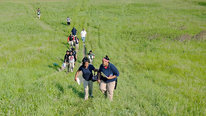- Graham Gardner
- http://www.cast.org/about/staff/graham-gardner.html
- Research Associate / Project Manager
- Presenter’s NSFRESOURCECENTERS
- CAST
- Samantha Daley
- http://www.cast.org/about/staff/samantha-daley.html
- Director of Research / Principal Investigator
- Presenter’s NSFRESOURCECENTERS
- CAST
- Sam Johnston
- http://www.cast.org/about/staff/sam-johnston.html
- Research Scientist / Co-Principal Investigator
- Presenter’s NSFRESOURCECENTERS
- CAST
Inquiry Primed: An Intervention to Mitigate the Effects of Stereotype Threat ...
NSF Awards: 1313713
2015 (see original presentation & discussion)
Grades 6-8
We are developing an online professional development course for 8th grade science teachers. The fifteen teachers that participate in a pilot the course in the fall of 2015 will learn about stereotype threat and practice strategies to reduce the negative effects in an inquiry science context. The course will address strategies and tools to improve instruction, feedback and student collaboration and will be infused with real student data from our experimental studies that found a negative classroom wide effect of stereotype threat on student collaboration. In this video we will discuss a brief overview of the project and the phenomenon of stereotype threat, our experimental study design and results, and our current plan for developing the online course to help teachers create a successful classroom environment.
Related Content for Inquiry Primed: Mitigating Stereotype Threat in Science
-
 2016PD to Reduce Stereotype Threat in Science
2016PD to Reduce Stereotype Threat in Science
Sam Catherine Johnston
-
 2021Interest Stereotypes Cause Gender Gaps in STEM Motivation
2021Interest Stereotypes Cause Gender Gaps in STEM Motivation
Marley Jarvis
-
 2019Coding Science Internship: CS for the Science Classroom
2019Coding Science Internship: CS for the Science Classroom
Ari Krakowski
-
 2021STEMMING the Tide in STEM
2021STEMMING the Tide in STEM
Katherine Picho-Kiroga
-
 2020Coding Science Internship Units: CS for Science Classrooms
2020Coding Science Internship Units: CS for Science Classrooms
Ari Krakowski
-
 2022Urban Environmental Stewards: Youth Aid Community with STEM
2022Urban Environmental Stewards: Youth Aid Community with STEM
Connie Flanagan
-
 2018Redesigning Environments Increases Girls' Interest in CS
2018Redesigning Environments Increases Girls' Interest in CS
Sapna Cheryan
-
 2019Stereotypes about Brilliance Are a Barrier to STEM Diversity
2019Stereotypes about Brilliance Are a Barrier to STEM Diversity
Andrei Cimpian



Brian Drayton
Very interesting.
How are you establishing the students’ perceptions or other evidence of stereotype threat as they see it or experience it?
Samantha Daley
Director of Research / Principal Investigator
Hi Brian,
Thanks for the question. We have three types of measures from various perspectives. At the end of each lesson, students and teachers (who were blind to condition) answered brief surveys rating the levels of collaboration/interaction during that class period. Items are along the lines of “I believe others saw me as an important part of the group today.” In addition, observers (blind to condition) used the RTOP protocol. From that, we focused on the “classroom culture” items. These don’t give indication of stereotype threat directly, but the finding that all three were dampened on days when threat was primed suggest it is at play. Hope that helps!
Avron Barr
Consultant
How will you measure the impact of the PD materials you are developing? Is class-wide impact the best measure?
Samantha Daley
Director of Research / Principal Investigator
Hi Avron,
In this exploratory work, we will not be collecting data with students or in the teachers’ classrooms. Instead, our measures will focus on teachers’ perceived value of the PD experience and content, their level of engagement in the community of practice (via observations and analysis of event logs), and interviews. We’re drawing quite a bit from the community of practice literature (ie, Wenger). Ideally, we’ll follow up from this first run of piloting with a classroom-based study targeting the most promising strategies.
Lisa Hogan
Technology Integrator
Based on the data from your experimental studies finding a negative classroom wide effect of stereotype threat on student collaboration, do you have any thoughts about challenges teachers might encounter as they implement strategies to reduce the negative effects in an inquiry science context and how you will help teachers with these challenges?
Samantha Daley
Director of Research / Principal Investigator
Hi Lisa,
Thanks for the question! We have been working closely with teacher co-designers in developing the PD experience. As they try out different strategies and activities, we’re finding that some are relatively straightforward to integrate into daily instruction – e.g., attending to ways of providing feedback that encourage all learners — while others are more of a stretch. Some strategies particularly seem to be perceived as more in the realm of a guidance counselor’s role. This has been very helpful input as we work together to make strategies usable and feasible.
Elizabeth Hassrick
Research Scientist
Such critical work, to uncover how social and racial dynamics shape peer interactions in classrooms. Very difficult dynamics to measure. Could you share any observational findings related to how already established social networks among peers were protective or undermining, with regard to stereotype threat?
Samantha Daley
Director of Research / Principal Investigator
Hi Elizabeth,
Thanks for the thoughtful question! While I’m not sure we can address this directly, we did observe interesting differences between teachers’ approaches to grouping students – particularly when students were able to form their own collaborative groups vs being assigned by the teacher. In one set of classes, students could also opt out of group work and choose to work independently. We’re just getting into analysis of how these different approaches relate to experiences of the class.
Further posting is closed as the event has ended.